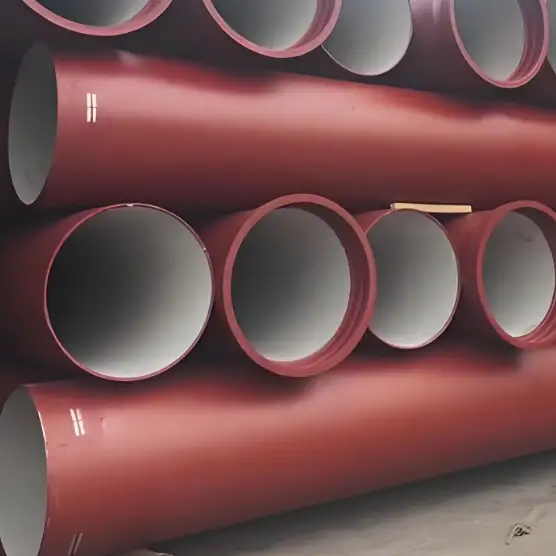Ductile iron (DI) pipes are widely used for water distribution, wastewater systems, and industrial applications due to their exceptional strength, durability, and resistance to corrosion. Understanding the various grades of DI pipes is crucial for selecting the right product for a specific application.

1. Classification by Wall Thickness and Pressure Capacity
DI pipes are often categorized according to their wall thickness and ability to withstand various pressures. Two primary classifications used by manufacturers include:
K-Class (Wall Thickness)
-
What It Is: K-class designations (e.g., K7, K8, K9) indicate the pipe’s wall thickness. A higher K-number typically means a thicker wall and enhanced strength.
-
Applications: Higher K-class pipes are preferred in installations where mechanical performance is crucial, such as high-pressure water mains or industrial piping systems.
C-Class (Pressure Capacity)
-
What It Is: C-class grades (e.g., C25, C30, C40) are based on the pipe’s allowable working pressure. These classes directly correlate with the design pressure, ensuring pipes meet the necessary requirements for different operating conditions.
-
Applications: These grades are essential in high-pressure environments and critical infrastructures, where reliability under fluctuating pressures is mandatory.
Example Data Table – DI Pipe Wall Thickness and Pressure Ratings:
| Grade Type | Grade Example | Nominal Pressure Rating | Description | Common Use |
|---|---|---|---|---|
| K-Class | K8 | Varies with diameter | Moderate wall thickness, ideal strength | Urban water distribution |
| K-Class | K9 | Varies with diameter | Increased wall thickness for higher loads | Heavy-duty industrial applications |
| C-Class | C25 | 25 bar | Standard pressure rating | Municipal supply systems |
| C-Class | C40 | 40 bar | High-pressure applications | Critical infrastructure and hydraulic systems |
Table Note: Values are indicative and may vary with region-specific standards.
2. Mechanical Grades According to ASTM Standards
Mechanical properties such as tensile strength, yield strength, and elongation rate are critical for determining the durability and ductility of DI pipes. ASTM A536 is one of the most widely referenced standards for DI pipes, and it categorizes them into specific mechanical grades:
-
60-40-18 Grade:
-
Tensile Strength: 60,000 psi
-
Yield Strength: 40,000 psi
-
Elongation: 18%
Suitable for lower-pressure systems with moderate load requirements.
-
-
65-45-12 Grade:
-
Tensile Strength: 65,000 psi
-
Yield Strength: 45,000 psi
-
Elongation: 12%
Chosen for systems requiring a balance between strength and ductility.
-
-
80-55-06 Grade:
-
Tensile Strength: 80,000 psi
-
Yield Strength: 55,000 psi
-
Elongation: 6%
Used in applications where high strength is prioritized over ductility.
-
-
100-70-03 Grade:
-
Tensile Strength: 100,000 psi
-
Yield Strength: 70,000 psi
-
Elongation: 3%
Ideal for extreme pressure and load applications.
-
3. International Standards and AWWA Pressure Classes
In addition to K- and C-classes and ASTM grades, DI pipes in North America often adhere to AWWA (American Water Works Association) pressure classes. These classifications, such as Class 150, Class 250, and Class 350, specify the maximum working pressure (in psi) that a pipe can safely handle. For instance:
-
Class 150: Suitable for lower-pressure applications in residential and small community water systems.
-
Class 250: Commonly used for municipal water supplies and medium-pressure systems.
-
Class 350: Developed for high-pressure industrial and large-scale municipal systems.
International Compatibility:
Manufacturers ensure that DI pipes adhere to standards like ISO 2531 (global), EN 545/EN 598 (European), ASTM A536 (North American), and regional adaptations to meet local environmental and infrastructure requirements. This compatibility allows DI pipes to be selected confidently for international projects.
4. Special Processing: Austempered Ductile Iron (ADI)
Austempered Ductile Iron (ADI) represents a specialized category where ductile iron undergoes an austempering heat-treatment process. The benefits include:
-
Enhanced Strength and Toughness: ADI pipes possess improved wear resistance and fatigue strength.
-
Specialized Applications: Frequently used in demanding industrial environments and for components exposed to high-impact or abrasive conditions.
5. Case Studies: Real-World Applications
Case Study 1: Municipal Water Upgrade in Europe
A European city modernized its water distribution network by replacing older pipes with K9 and C40 DI pipes:
-
Impact: A 30% reduction in maintenance downtime over a 10-year period.
-
Standards Compliance: The project met EN 545 standards and utilized data-driven selection processes to ensure optimal pressure and load handling.
Case Study 2: Industrial Application in North America
A manufacturing plant upgraded its cooling water system using ASTM 80-55-06 and AWWA Class 250 pipes:
-
Outcome: The new system provided enhanced operational safety and reduced energy loss under high-pressure conditions.
-
Data-Driven Decision: Engineers used mechanical property charts and pressure capacity data to choose the most suitable grades.
The diverse grades of DI pipes—ranging from K-Class and C-Class to ASTM and AWWA standards, including advanced grades like ADI—provide tailored solutions for various pressure and mechanical requirements.
References:
- ASTM A536 – Standard Specification for Ductile Iron Castings – ASTM International
- AWWA Standards for Ductile Iron Pipe Pressure Classes – American Water Works Association
- ISO 2531: Ductile Iron Pipes, Fittings, Accessories and Their Joints for Water Applications – International Organization for Standardization
- EN 545: Ductile Iron Pipes, Fittings, and Their Joints for Water Pipelines – European Committee for Standardization (CEN)
- Austempered Ductile Iron (ADI) – Wikipedia

